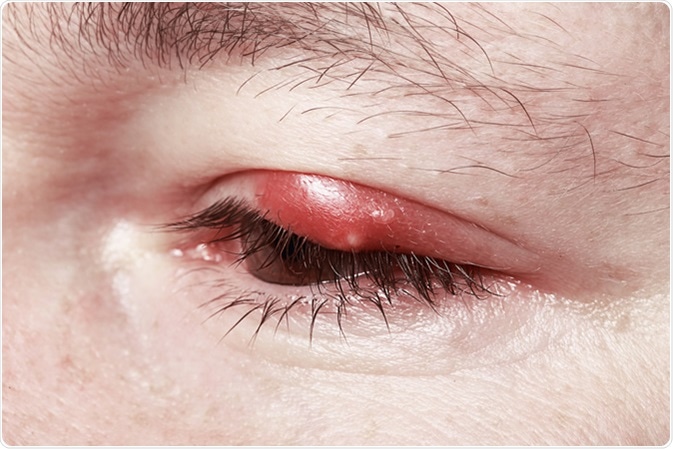Blepharitis Types and Causes

A common disorder of the eye, blepharitis, is a condition in which there is visible inflammation in the eyelids. Bacteria causes irritation and the eyelids become red and itchy. Though it does not cause permanent damage to vision, blepharitis causes discomfort to patients. Women in their peri- and post-menopausal stage are more prone to the dysfunction of the meibomian glands.

Types of Blepharitis
Blepharitis is classified into three types:
- Anterior blepharitis
- Posterior blepharitis
- Mixed blepharitis
In anterior blepharitis, the eyelid skin, base, and follicles of the eyelashes are affected—the outside of the eyelid, in the front edge attached to the eyelashes. Posterior blepharitis occurs at the inner edge, the eyelid that is in contact with the eyeball. In some patients, both anterior and posterior type of blepharitis can occur, which is termed as mixed blepharitis.
Causes of Anterior Blepharitis
Staphylococcal infections or seborrheic dermatitis is the main cause of anterior blepharitis.
Staphylococcal Infections
Symptoms such as mild sticky eyelids, thicker margins of the eyelid, and missing eyelashes occur due to Staphylococcal blepharitis.
Although Staphylococcus bacteria are commonly present in the skin, nose, buttocks, and the surface of the armpits, they can enter the human body through a cut or insect bite in the skin or through skin openings while using medical equipment (for example, urinary catheters).
The bacterium Staphylococcus causes a group of infections, from minor skin and soft tissue infections to invasive infections called Staphylococcal infections or staph infections. Among the many varieties of Staphylococci, the bacterium Staphylococcus aureus consists of methicillin-resistant Staphylococcus aureus (MRSA), which resists antibiotics such as flucloxacillin, commonly used for staph infections. Staphylococcus aureus, the cause of most infections has PVL-Staphylococcus aureus, which generate Panton-Valentine leukocidin (PVL), a toxin that kills white blood cells resulting in recurring skin infections.
Even though infections can affect healthy individuals, people with a weak immune system (for example, patients undergoing chemotherapy) are more prone to these infections.
Seborrhoeic Dermatitis
Seborrhoeic dermatitis is a type of eczema visible in places where the sebaceous glands are active. The yeast Malassezia furfur is said to activate seborrhoeic dermatitis. Sebum production is, however, not related to the severity of the eczema. Some individuals are free from eczema even though the sebum production is higher. Though the exact cause of Seborrhoeic dermatitis is not understood completely, conditions such as depression, epilepsy, heavy intake of alcohol, and medications such as psoralen, lithium, and interferon induce the risk of Seborrhoeic dermatitis.
Blepharitis could be due to metabolites such as reduced fatty acids, rise in the levels of oleic acid, and increase of cholesterol and triglycerides. Symptoms such as red scaly margins in the eyelid are visible.
Causes of Posterior Blepharitis
In posterior blepharitis, problems are associated with the inner part of the eyelid. The eyelid margins have minute oil glands, called meibomian glands. These are positioned in both the lower and upper eyelids with each lid carrying 15–20 glands. The openings of the glands lie inside the line of the eyelash, typically on the eyelid edges. The oil percolates slowly when the eyes are blinked; however, the gland collapses when it is empty.
The oil produced by this gland merges with the watery component in the eye and together a tear film is created. This oily layer provides a coating to the water layer and protects the water from evaporation. When the quality or quantity of the water or oil is altered, there are symptoms such as eye irritation.
Meibomian blepharitis shows symptoms such as poor tear quality and redness in the eyelid lining. This is because the glands in the eyelids produce oil irregularly, which also favors bacterial growth. The secretions of the meibomian glands are broken down by the bacteria, causing irritation to the eye, while giving a foamy look to the tear film. The excess oil that is formed along the edge of the eyelid will lead to inflammation, crusty, with flakes.
The inflammation of the margin of the eyelid can put a ceiling on the meibomian gland slits. This obstruction will decrease oil production and the oil that stays in the gland will be thick and contaminated.
What Causes Meibomian Gland Dysfunction?
Although there are many conditions for the dysfunction of the meibomian glands, one particular skin condition, rosacea, can block the functioning of the meibomian gland.
The species Demodex folliculorum found in follicles of the hair and in meibomian glands is present in larger quantities in rosacea patients. The over deposit of these species may possibly prompt the immune system, as in many rosacea patients the eyes may appear red or watery (ocular rosacea) and patients have a feeling of irritation in the eyes.
The two species of Demodex, the genus of tiny mites, are responsible for blepharitis. Anterior blepharitis is caused by Demodex folliculorum and posterior blepharitis is caused by Demodex brevis. While the Demodex mite creates direct damage, it also carries the bacteria Staphylococci that cause Staphylococcal infections.
Sources
- http://www.nhs.uk/conditions/blepharitis/Pages/Introduction.aspx
- www.nhs.uk/…/Introduction.aspx
- http://eyewiki.aao.org/Blepharitis
- www.aad.org/public/diseases/scaly-skin/seborrheic-dermatitis#causes
- http://dryeyezone.com/encyclopedia/mgcare.html
- http://eczema.dermis.net/content/e02causesof/e441/e446/index_eng.html
- http://blepharitistreatment.org.uk/
- www.aoa.org/…/blepharitis?sso=y
- www.guysandstthomas.nhs.uk/…/…mmatory-condition-of-the-eyelids.pdf
- https://www.eyeworld.org/article-new-antibiotic-opti
- https://www.aapos.org/terms/conditions/141
- https://www.rosacea.org/patients/causes/demodex
- https://www.ncbi.nlm.nih.gov/pmc/articles/PMC2946818/
Further Reading
- All Blepharitis Content
- Blepharitis Complications
- Blepharitis Diagnosis and Treatment
Last Updated: Aug 23, 2018

Written by
Susha Cheriyedath
Susha has a Bachelor of Science (B.Sc.) degree in Chemistry and Master of Science (M.Sc) degree in Biochemistry from the University of Calicut, India. She always had a keen interest in medical and health science. As part of her masters degree, she specialized in Biochemistry, with an emphasis on Microbiology, Physiology, Biotechnology, and Nutrition. In her spare time, she loves to cook up a storm in the kitchen with her super-messy baking experiments.
Source: Read Full Article